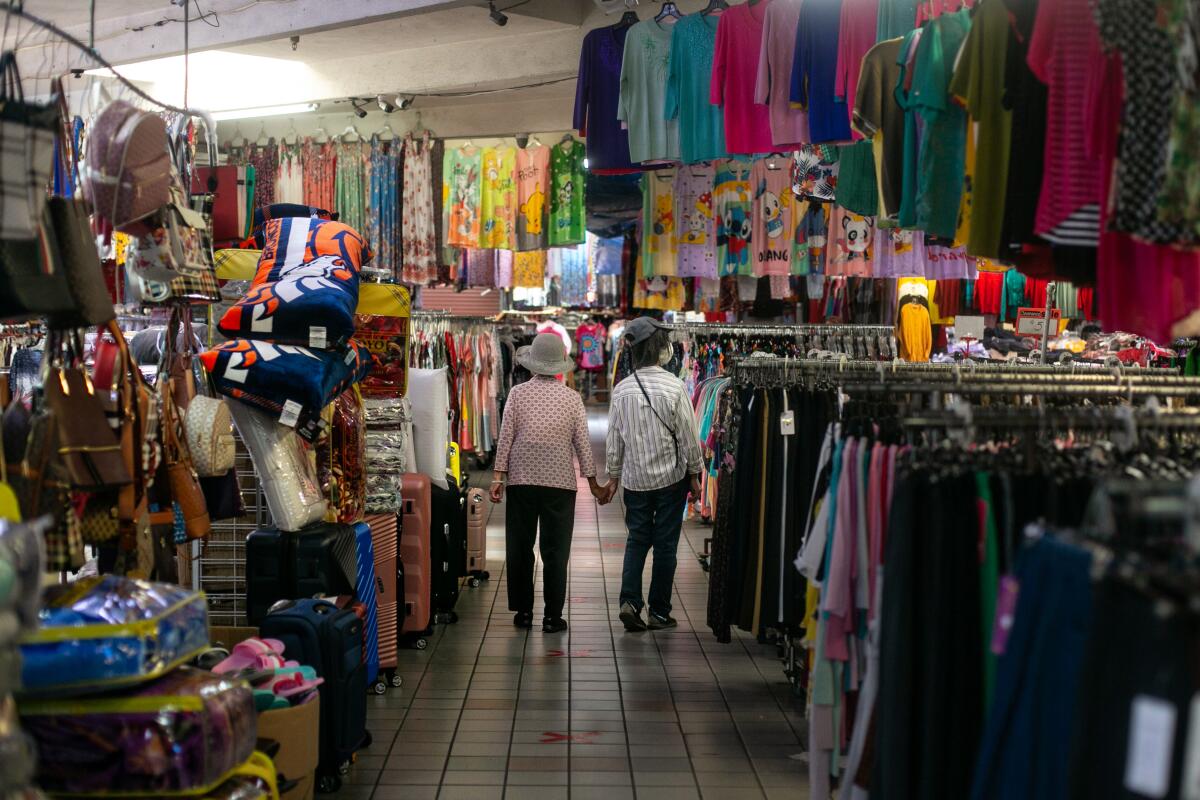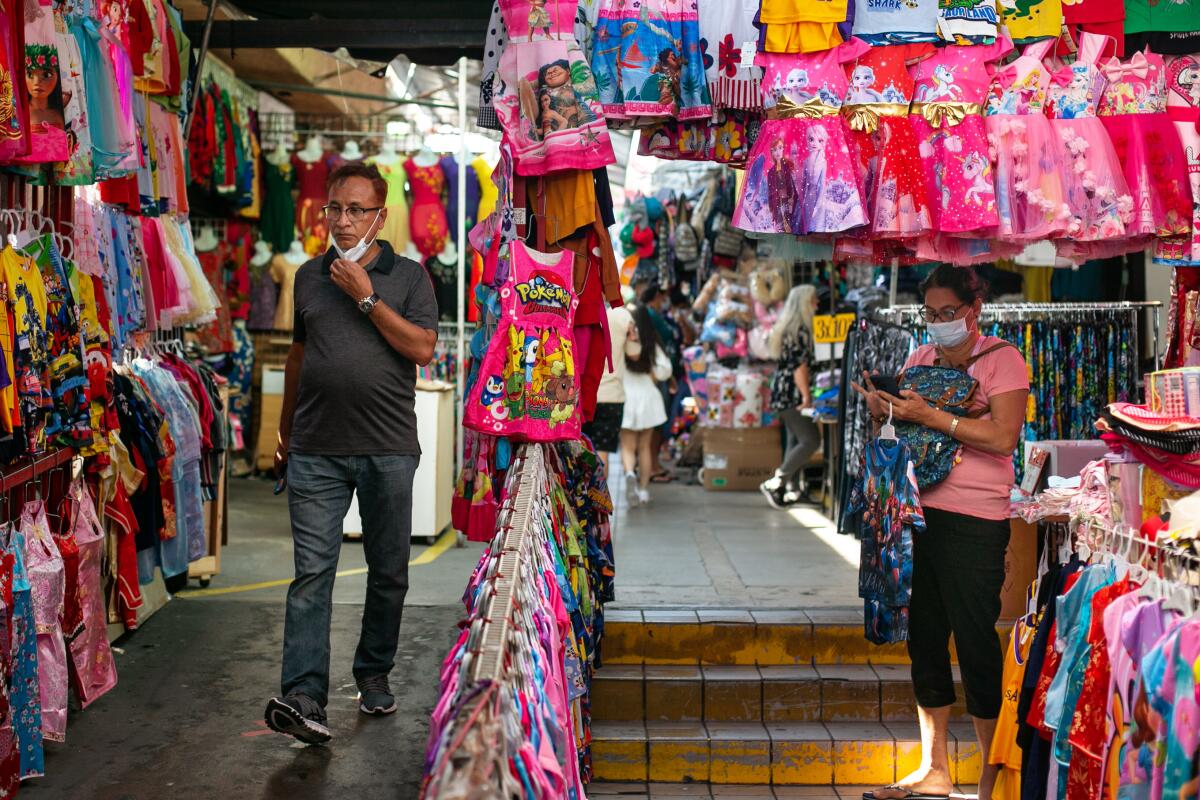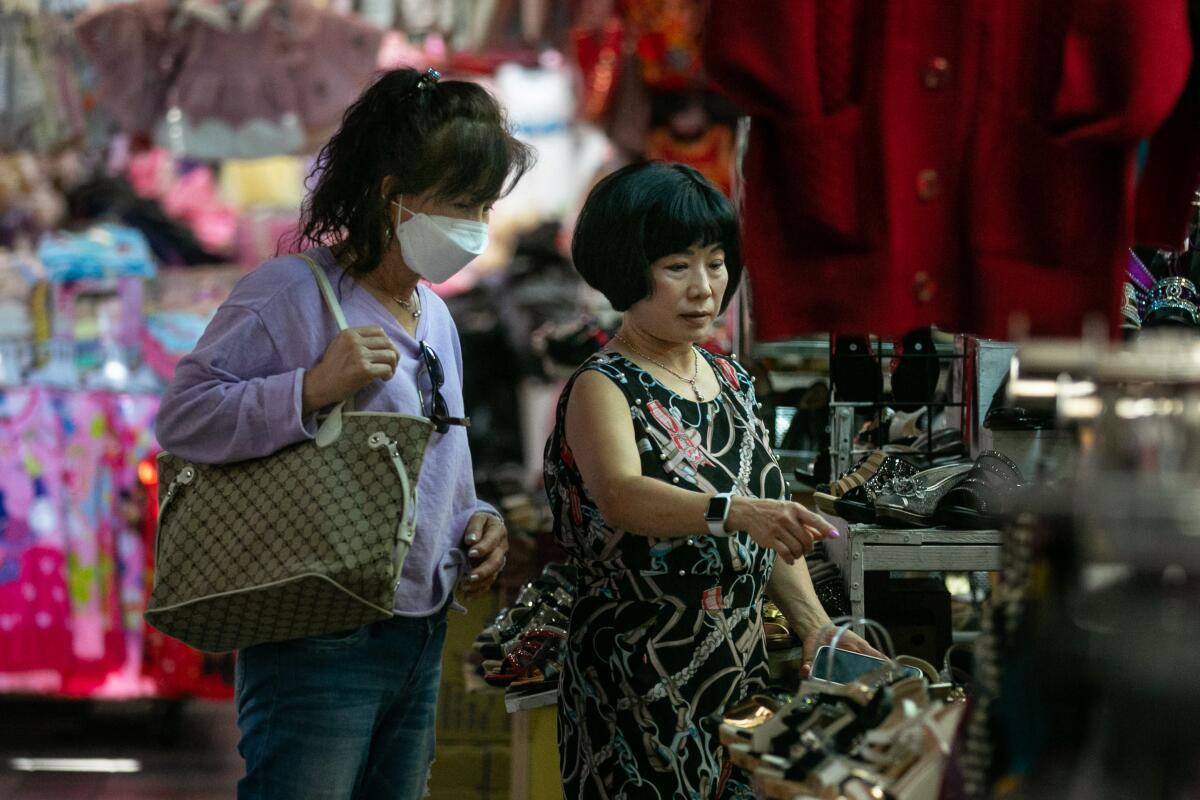Column: Chinatown’s swap meets and what defines a neighborhood

- Share via
When I think of Chinatown, my mind goes to the swap meets, and muffled music from a half-dozen portable radios, TVs and smartphones starts to play in my head.
If you listen closely, you can make out the tinny chatter of Vietnamese and Cambodian variety shows, Cantonese pop songs from the ’80s and Mandarin-language newscasts in the swap meet’s eerie, still air. It’s a fitting soundtrack to Chinatown’s many immigrant diasporas, oddly forlorn and nostalgic.
The swap meets, which contain the majority of Chinatown’s businesses, are facing redevelopment. They have for decades attracted immigrants from all over the Southland with a commodity that translates in any language: bargain-basement deals on clothing, home goods, luggage, toys, gifts and anything else that fits in a shipping container.

Once spanning an entire block, Chinatown’s swap meets have been drastically reduced since I wrote about them four years ago. The model weapon vendor I bought a “The Last Samurai” replica sword from for $20 is gone, but his inventory remains, having effected a bizarre merger with that of a neighboring toy shop. There are no longer fidget spinners at every store — evil eye charms, keychains and ornaments seem to be the current trend.
The lady who proudly modeled her silk dresses in the video we filmed to go with the story is gone too, replaced by a woman who smiles much less. A Taiwanese clothing vendor who once ran two shops has been relegated to a single store.
Time and the pandemic have left the swap meet’s hallways pockmarked with shuttered businesses; nearly half the vendors are gone. A few months ago, Redcar Properties bought more property in the swap meets, and though no one has been issued an eviction notice, vendors there say they have little hope that they’ll be able to remain. The real estate development firm previously purchased and transformed the neighboring swap meet, the Shops, into an architectural office space.

The possible redevelopment of the swap meets, which once contained the majority of Chinatown’s businesses, prompts philosophical questions about Chinatown.
What is a neighborhood, really? What are its components or vital organs? Where is its heart, brain, lungs? Is it people, places, buildings, businesses, land, all of that, some of that? Is it something more dogmatic, like an official city designation marked on planning maps, a signpost, an additional line in your address? Or is it amorphous, like an identity or an idea?
The reason I ask is because all of these changes point to a bigger question about Chinatown: How do you know when it’s gone?
In the next few years, the affordable housing covenants that allow the area’s seniors to pay below-market rent will expire, opening the door for redevelopment and a dramatic decline in the area’s ethnic Chinese population. Between 1990 and 2020, the area’s Asian population fell from 68% to 54%, while the area’s white population rose from 1% to 10%, according to census data.
It’s widely known that the owners of Chinatown’s remaining swap meets are looking to sell their property.
Chinatown’s last full-service grocery store, Ai Hoa, closed two years ago after Redcar assumed ownership, and its last hospital in 2017.
And across Chinatown, low-income residents are fighting to stay in their homes as developers raise rents, issue evictions notices and seek to redevelop. The land beneath Chinatown has grown too profitable for Chinatown’s community to exist on top of it.
And the story of Los Angeles’ Chinatown isn’t unique, unfortunately. I’ve been going to Chinatowns all my life, and over the last few years I’ve made a habit of visiting Chinatowns everywhere I go.
Something in me is thrilled by the discovery that no matter if I’m in Houston, Atlanta, Philadelphia or Detroit, I can still spot the hallmarks of diaspora: a Chinese bank-sponsored glossy calendar on the wall, the gilded storefront of a benevolent association, or a familiar Chinese newspaper. It’s like a piece of home that follows me around the world.
In Kolkata’s Chinatown, I encountered a community of leather tanners and restaurateurs and Chinese people who spoke Bengali and English but no Mandarin. There were no gift shops or swap meets — only tanneries, temples and restaurants. The restaurants served a chop suey drowning in gravy and spiced like curry. I toured the local Chinese school, which was built six stories high with a temple at the top, but the student body has declined so much that the ambitious development now goes largely unused.
In Vancouver, Canada, I found a deserted Chinatown existing mostly in historical signposts and placards.
In Yokohama, Japan, there was a Chinatown mostly existing as a tourist destination, where the baozi came shrink-wrapped in six packs and the dim sum format was all you can eat, ordered through iPads rather than carts.
Yokohama’s Chinatown was also on the decline, and the same goes for every Chinatown I’ve ever visited.
But each Chinatown has also been a powerful example of resilience. It is a home away from home, for people who were forced from their homes. And the commonalities I encounter in Chinatowns are powerful reminders of how all immigrants are connected by their struggle to find and create a home.

No place in Chinatown to me embodies that better than the swap meets, where homeland resentments and language barriers are shrugged aside in order to conduct the business of survival. Chinatown leaders may complain about their dilapidated condition and the trash the swap meets create, but they are one of the few remaining places where immigrant entrepreneurs can shoulder the cost of running their own business.
Long Ta, a Chinatown jeweler I’ve grown familiar with over the years, built his business in the swap meets when he was in his twenties and now owns various properties nearby. He thinks the Chinatown will be around for at least another 30 years. I found his estimate highly optimistic, but as one of the last Asian land owners on his block, he probably knows better than I do.
“With change, there’s always good and bad. We want to maintain our culture, but we also want to move forward,” Ta said.
More to Read
Sign up for Essential California
The most important California stories and recommendations in your inbox every morning.
You may occasionally receive promotional content from the Los Angeles Times.











